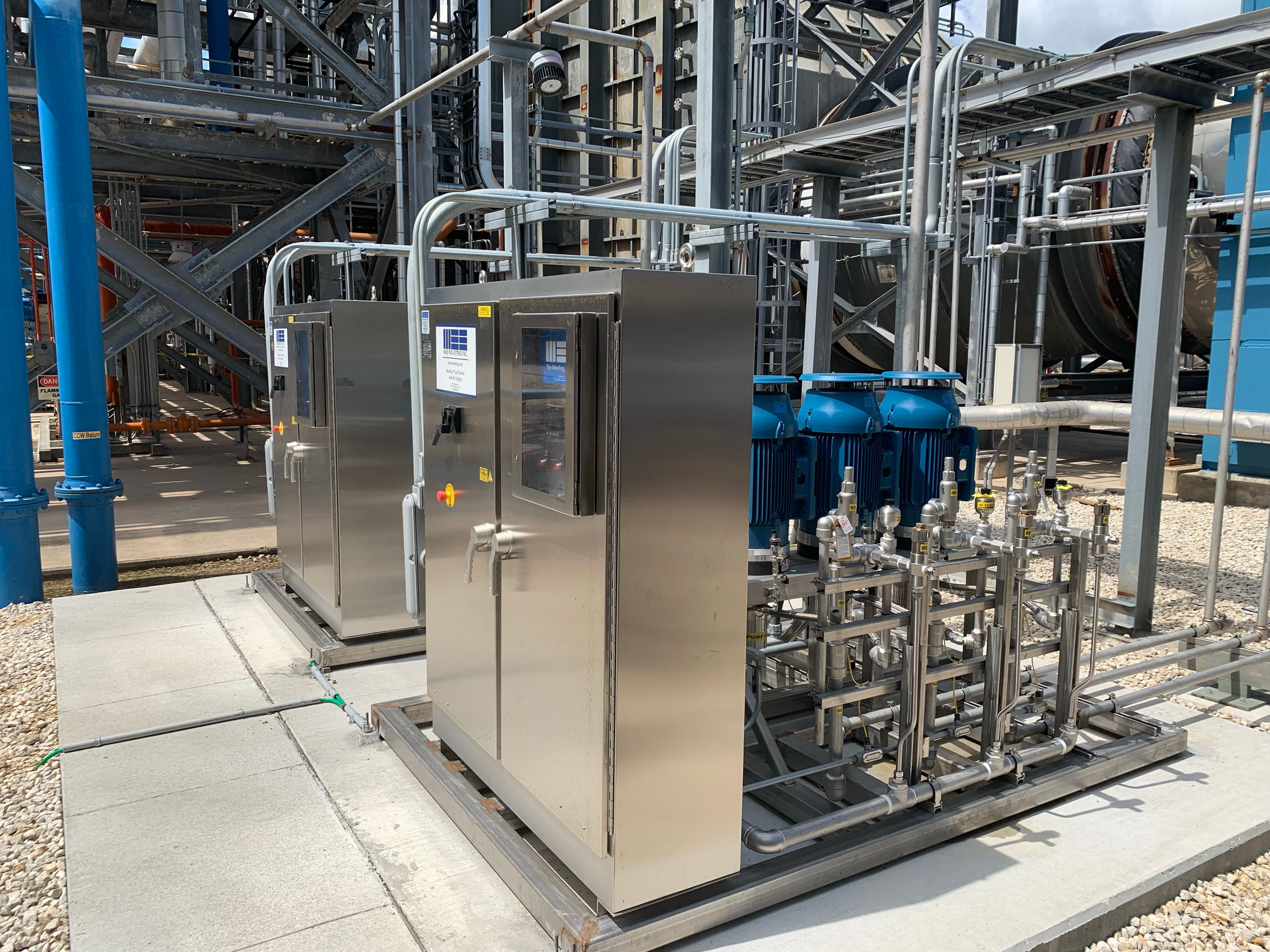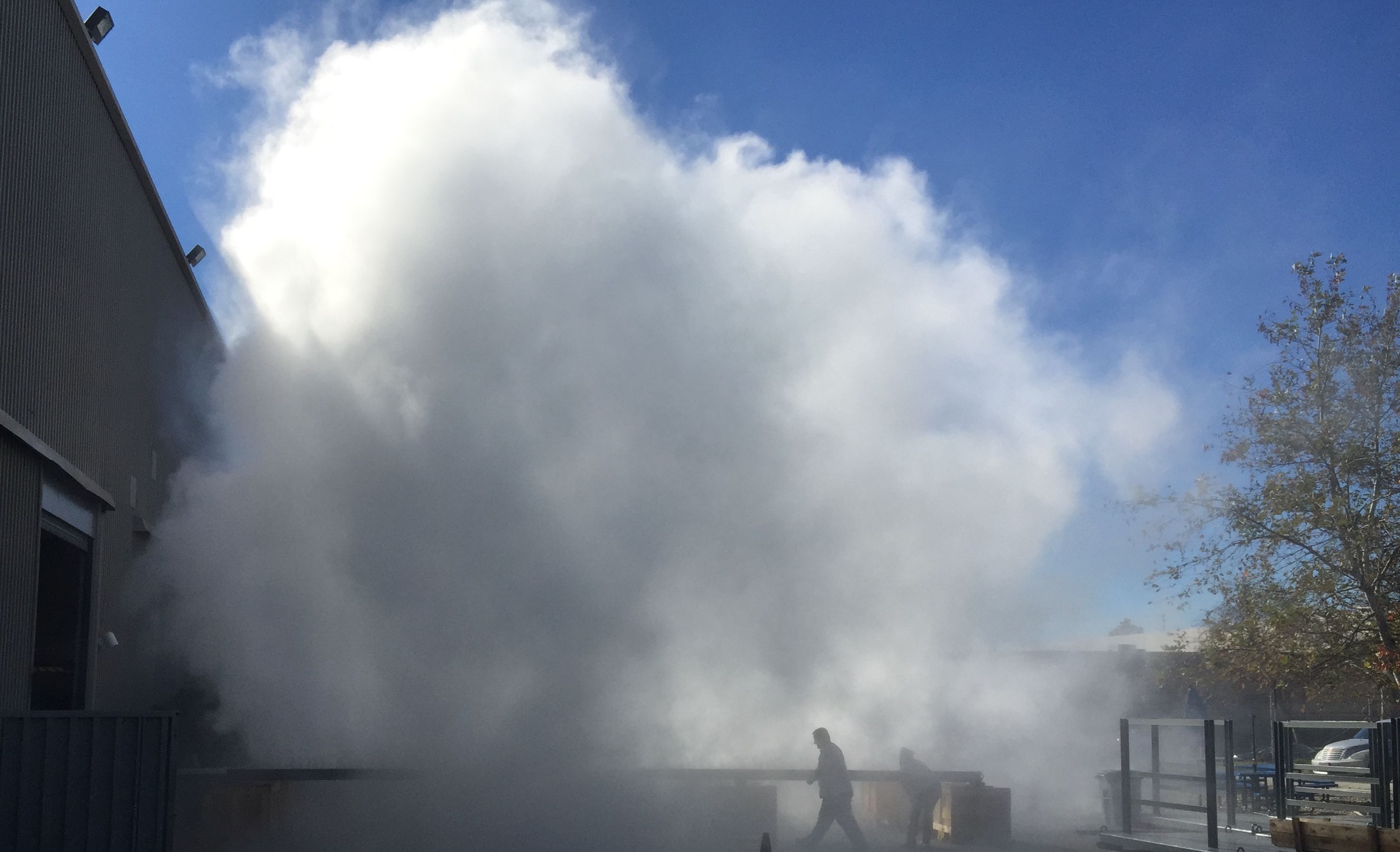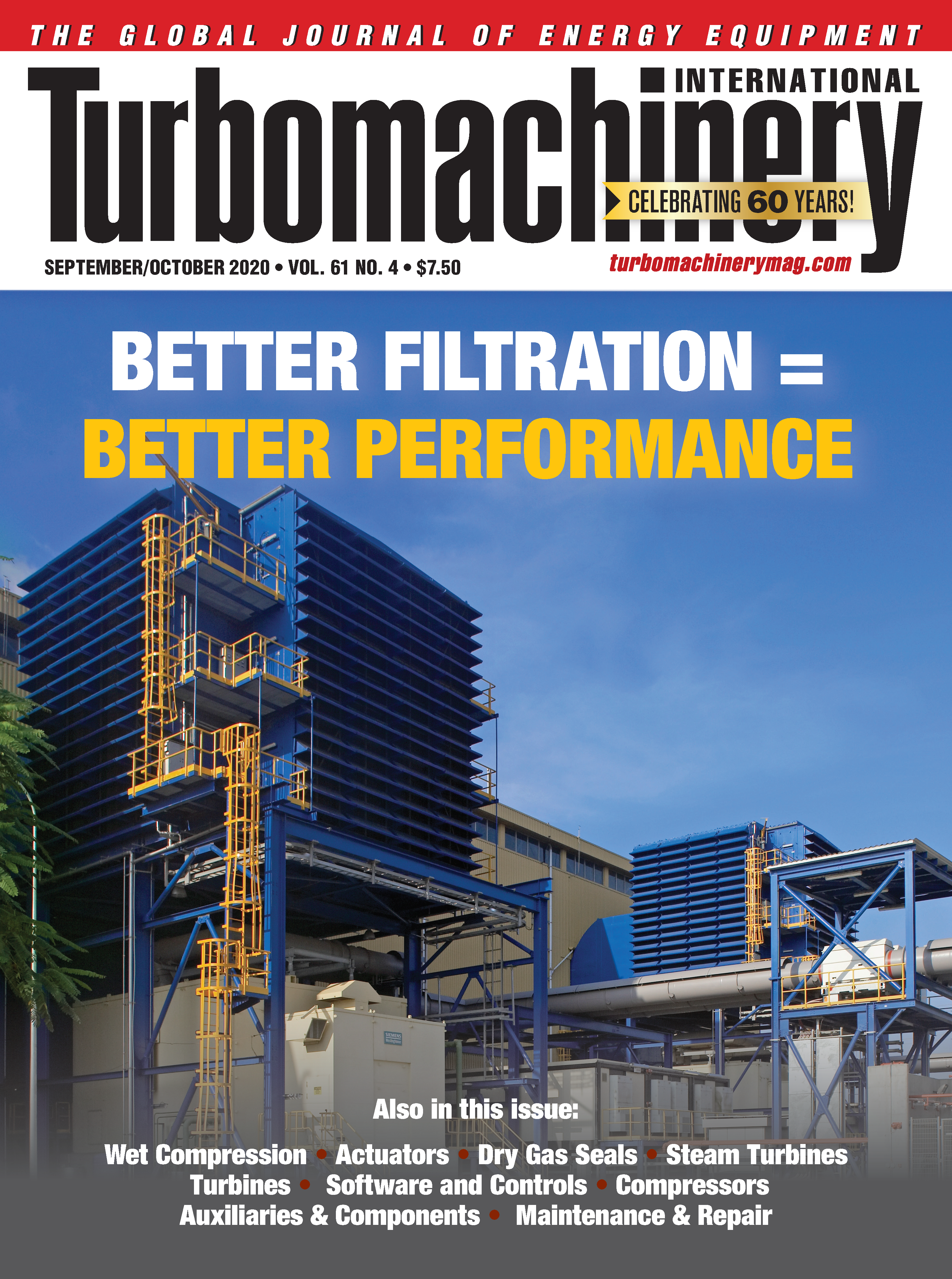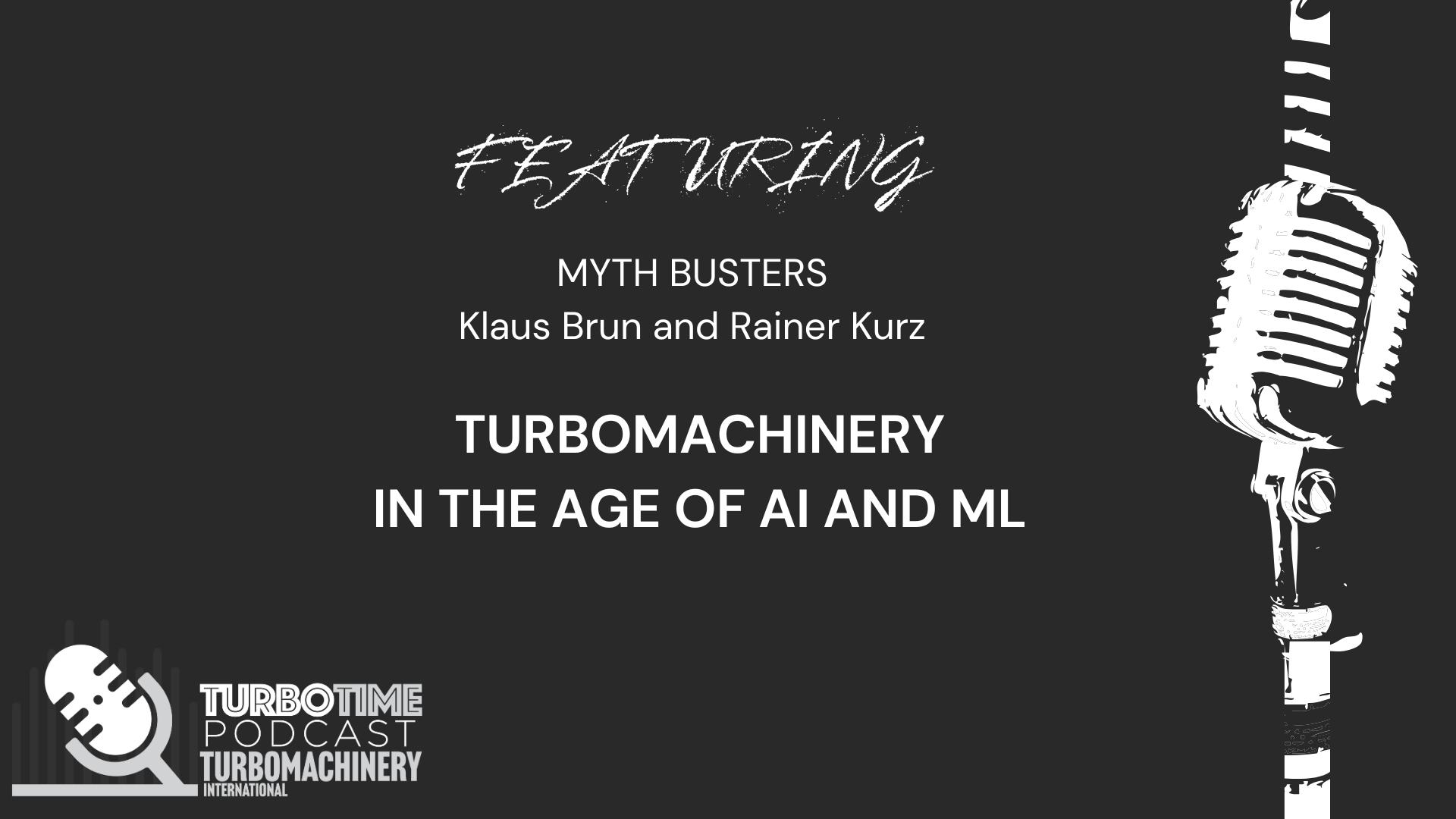Publication
Article
Turbomachinery Magazine
A multi-decade perspective on wet compression
Author(s):
MeeFog wet compression pump skids serving a combined cycle plant.

Wet compression consists of spraying atomized water into the compressor of a gas turbine engine. It is usually done after the air has been fully humidified by fogging, evaporative cooling with a media-type cooler or by chilling the air to below the ambient dew point temperature. The heat of compression causes the water droplets to evaporate inside the compressor where they provide an inter-cooling effect. This reduces the work of compression. Since the compressor consumes less power, more power is available at the GT output shaft.
A gas turbine compressor consumes half or more of the work produced by the expansion turbine. Therefore, an increase in compressor efficiency can produce a significant rise in the power output and fuel efficiency of a gas turbine. The added mass flow of water also causes a power increase. But this is small compared to the power boost resulting from the reduced work of compression.
History
Wet compression has been around for many decades. The first gas turbine that produced useful shaft power (built by Norwegian inventor Jens William Elling in 1903) used two, three-stage axial compressors with inter-stage water injection. Wet compression was also used in developing extra thrust during takeoff for both commercial and military airplanes from the late 1930s through the 1970s. The first patents for wet compression for industrial gas turbines date back to the 1940s.
More recently, NASA has funded research into the use of water injection into aero engine compressors to reduce NOx emissions from commercial aircraft during takeoff. Such systems also reduce hot-section temperature for the same thrust, thus potentially decreasing engine maintenance costs. This has led some researchers to suggest the use of wet compression for takeoff and the climb to cruising altitude.
In 1996, Mee Industries installed a wet compression system at the Ralph Green Power Station in the U.S. as part of an EPRI capacity enhancement program. The system cooled the inlet air and injected an “overspray” of liquid water at a rate of about 0.5% of the air mass flow. The wet compression system produced a 6% increase in power for the GE-7EA turbine.
Nearly one third of the more than 1000 MeeFog systems installed on gas turbines around the world in the past 30 years were specifically designed to provide additional spray for wet compression. However, a fog system designed only for evaporative cooling can also be used for wet compression if it is operated when ambient conditions don’t allow for full evaporation of the fog spray. Wet compression systems typically have water flow rates from 0.5% to 2.5% of the gas turbine inlet-air mass flow rate—about 20 to 90 gpm for a 7EA turbine, or as much as 156 gpm of a large F-class.
MeeFog nozzles produce tiny droplets that stay suspended in the airstream.

Watson Cogen
One of the early adopters of modern wet compression systems was the Watson Cogeneration Plant in Southern California. It installed four wet compression systems in 1998 and continues to use fogging for most of the year.
Watson Cogen is headquartered in Carson, about 15 miles south of downtown Los Angeles. The owners of the plant are Marathon Petroleum and NRG. Watson provides high-pressure steam and electricity to the Carson Refinery, as well as electricity to the grid. The refinery is California’s largest. It produces gasoline, diesel fuel, jet fuel and anode-grade coke. In addition, the facility produces the gas powering Watson Cogen’s turbines.
The plant has four natural gas-fired GE 7EA turbines, each rated at 83.5 MW (ISO). Exhaust gases from these turbines feed a duct-fired heat recovery steam generator, which generates both high- and medium-pressure steam. Around half of the high-pressure steam goes to the refinery. The rest is sent to two Dresser Rand steam turbines powering electric generators.
Watson’s Principal Engineer, Steve Ingistov, an ASME Fellow, has steadily introduced improvements, innovations and upgrades to the facility which boosted output from an initial level of 385 MW up to 425 MW. The gas turbines were originally supplied with once-through evaporative coolers. When operated at their design flow of 200 gpm, excessive water carry over resulted in compressor blade erosion. To address this issue, the plant upgraded the first seven rows of compressor blades to Carpenter 450 stainless steel.
T = temperature, S = entropy, P = pressure.

Fogging added
The original fog systems at Watson were designed to provide 16 gpm of fog spray, which represents 0.35% of the air mass flow, or about 16°F of cooling. The fog systems were intended to provide evaporative cooling downstream of the under-performing evaporative coolers, plus wet compression fogging.
The nozzle array was installed downstream of the inlet air silencer panels. Fog that didn’t evaporate in the inlet duct, entered the compressor where it provided a power boost. On cool and humid days, nearly all the fog failed to evaporate in the duct. It entered the compressor as wet compression spray.
In 2010, Ingistov removed the once-through, 150 gpm evaporative coolers, in part due to regulatory pressure to reduce the amount of water consumed. He relocated the nozzle arrays upstream of the silencer panels, with the fog nozzles aligned so they sprayed into the gaps between the panels. The new nozzle arrays spray 30 gpm of fog, which equates to 30°F of cooling, or 0.67% of the air mass flow, for the GE 7EA turbines.
Watson Cogen is close to the Pacific Ocean so it tends to be cooler and more humid than inland Southern California. Hot summer day conditions are given as 92°F dry bulb, 68°F wet bulb. It is possible to get about 23°F of evaporative cooling on a typical hot day.
Ingistov uses fog aggressively to achieve the greatest output. Since 2010, he has been operating all the fog nozzles whenever the ambient temperature is above 50 °F (nearly 24-hours a day, year-round). During cool and humid days and nights, most of the fog spray fails to evaporate in the inlet air duct and enters the compressor. On warm, dry days, most of the fog evaporates before entering the compressor, so most of the power boost is due to evaporative cooling. Evaporative cooling gives about twice the power boost of wet compression per mass-unit of spray.
Ingistov conducted a controlled experiment to compare media-type evaporative cooling with fogging. The evaporative cooler was removed from Unit 4 and replaced by a fogging array with a flow rate of 30 gpm. Performance measurements over several months demonstrated that for the vast majority of days, Unit 4 with only fogging outperformed the other units which had the evaporative coolers and the original 16 gpm fogging arrays. Under certain conditions, the evaporative coolers added almost no power. With the new system, when it is cool and the relative humidity is high, the evaporative cooler gives almost no power boost, while fog continues to boost performance through wet compression.
Taking into consideration the water consumption and the test results showing fog to offer a greater long-term performance boost, a decision was made to remove the rest of the evap coolers and replace them with fog nozzle arrays.
The facility has ran only the 30 gpm MeeFog systems for fogging and wet compression for nearly a decade. According to Ingistov, “during 20 years of operation, the MeeFog wet compression system has not caused blade erosion.”
By Thomas Mee
Thomas Mee is CEO of Mee Industries, a manufacturer of inlet air fogging and wet compression systems with more than 1,000 installations around the globe. For more information, visit MeeFog.com.

Newsletter
Power your knowledge with the latest in turbine technology, engineering advances, and energy solutions—subscribe to Turbomachinery International today.





